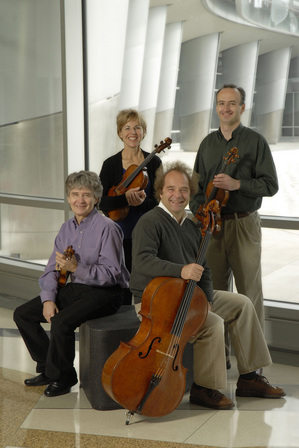3 Takács Quartet members bringing Beethoven and more to Rackham

The full Takács Quartet.
There’s no denying the modernity of Beethoven’s music, even today, though it is sometimes hard to realize how revolutionary some of it would have been to the ears of 18th and early 19th century listeners. And there is no denying that musicians exploring his scores continue to find new things to ponder and admire on each reading.
That’s certainly the case for the top-notch Takács Quartet, whose recording of the complete Beethoven quartets won multiple awards and whose current members are partway through complete cycles in London and Madrid this season.
Ann Arbor is regular Takács stop, too, courtesy of the University Musical Society, and the ensemble’s Monday concert here at Rackham Auditorium was to have been “a sort of Beethoven sandwich,” as violist Geraldine Walther put it. Beethoven quartets from Op 18 and Op. 59 were to flank a contemporary Takács commission.
That was before violinist Karoly Schranz required surgery for a torn rotator cuff, a procedure that has temporarily turned the quartet into a trio.
PREVIEW |
But there is still Beethoven on the revised program that Takács first violinist Edward Dusinberre, violist Walther and cellist Andras Fejer play Monday at Rackham Auditorium. The bill includes Mozart’s Duo for Violin and Viola No. 2 in B-flat Major, K. 424; the Kodaly Duo for Violin and Cello, Op. 7; and Beethoven’s String Trio in G Major, Op. 9, No. 1. Look at it as an opportunity to hear the extraordinary members of the Takács in closer focus.
"Our revised March program features 2 of the great string duos,” said Dusinberre. “Mozart’s violin and viola duos are still extraordinary in their rich use of the instruments, (and they provide) provide an insight into Mozart’s early thinking about this combination, which led eventually to the Sinfonia Concertante in E-flat major, K. 364.”
As for the Kodaly duo for violin and cello, Dusinberre calls it “a more powerful statement than his string quartets.”
“It is a very good piece for us,” he added, citing the collaboration of the Takács players with the Hungarian folk-roots group Muzikas — which Ann Arbor was luckily enough to witness in joint concerts of the 2 groups.
And while concertgoers will miss hearing the Takács in Beethoven quartets this time, Dusinberre asks listeners to remember that the Beethoven Op. 9 string trios, written before any of his quartets, are masterpieces.
The G Major trio, which the group will play, “is full of virtuosic writing for the instruments,” he noted. “But particularly in the transitions you see Beethoven’s daring and ingenuity.” He characterizes the trio’s finale as “barnstorming.”
As Takács admirers know, each of the group’s performances is sui generis.
“It’s very important to all of us to make music in the moment, and not to feel we have to make it same way every time,” said violist Walther, the “new” member of the quartet, with 5 years in the ensemble after being principal viola of the San Francisco Symphony for many years. “To have others react to what you is wonderful and thrilling on stage with the other players.”
That in-the-moment quality is sure to find its place on stage Monday as the Takács players experiment with less is more.
Susan Isaacs Nisbett is a free-lance writer who covers classical music and dance for AnnArbor.com.
Takács Quartet performing Beethoven: String Quartet No. 14 live this fall:

